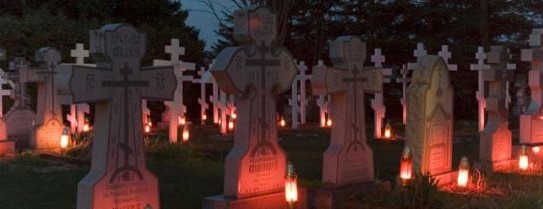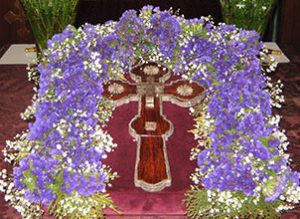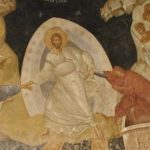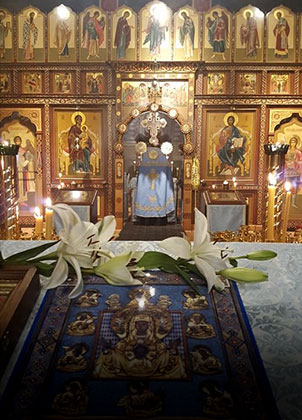Повесть афонского монаха о видении во время панихиды
Была родительская суббота, кончилась Литургия. Одни из присутствующих уже выходили из церкви, а другие остались и стали подходить к общему кануну (стоящему, по обыкновению, посредине церкви).

Я же, пишет монах, стоял на клиросе. Вышли из алтаря священник и диакон. Священник провозгласил: «Благословен Бог наш, всегда, ныне и присно и во веки веков. Аминь». Диакон зажег свечи, стал раздавать их присутствующим. И в это время я увидел, что много народа стало входить в дверь храма с улицы, а затем проникать сквозь стены и окна. Храм наполнялся множеством прозрачных теней. В этой массе я увидел женщин, мужчин, юношей и детей. Определил я по внешнему виду священников, императоров, епископов и между ними простого чернорабочего, дряхлого солдата-поселянина, бедную женщину и нищих вообще.
После возгласа священника они бесшумно, но чрезвычайно быстро заполнили собой весь храм, становясь тесно друг с другом. Все они как буд-то стремились к кануну, но почему-то не могли подойти к нему. Я не мог оторвать глаз от этой удивительной картины.
Наконец их набралось так много, что реальные молящиеся казались мне фигурами, ярко нарисованными на фоне этих удивительных теней. Они (тени), подходя в безмолвии, становились у священного алтаря. Некоторые из них как будто бы преклоняли колени, другие нагибали головы, точно ожидая произнесения приговора. Дети протягивали руки к свечам, горящим на кануне, и к рукам молящихся живых.
Но вот диакон вынул записки и начал читать написанные на них имена. Удивлению моему не было конца, когда я заметил, что порывистым, радостным движением выделялась то одна, то другая фигура. Они подходили к тем, кто помянул их, становились рядом с ними, глядели на них глазами, полными любви, радостного умиротворения. Мне даже казалось, что в руках духов появилась какая-то духовная горящая свеча и они сами, молясь вместе с молящимися за них, сияли необыкновенно радостными лучами.
По мере того как прочитывалось каждое имя, из толпы безмолвных теней все более выделялось радостных фигур. Они бесшумно шли и сливались с живыми молящимися. Наконец, когда записки были прочитаны, осталось много неназванных – грустных, с поникшей долу головой, как будто пришедших на какой-то общий праздник, но забытых теми, кто бы мог пригласить их на это великое для них торжество. Некоторые из душ тревожно посматривали на дверь, словно ожидая, что, быть может, придет еще близкий им человек и вызовет их в свою очередь.
Но нет, новые лица не появлялись, и неназванным оставалось только радоваться радостью тех, которых призвали пришедшие для единения с ними.
Я стал наблюдать за общей группой молящихся, которая как бы смешалась с дрожащими в светлых лучах призраками из потустороннего мира, и увидел еще более чудную картину.
В то время, когда произносились слова «Благословен еси, Господи, научи мя оправданиям Твоим» или слова «Сам, Господи, упокой души усопших раб Твоих», видно было, как лица живых озарялись одинаковым светом с лицами отошедших, как сердца сливались в одно общее сердце, как слезы не уныния, а радости, текли из глаз тех, кто носил телесную оболочку, и в то же время какой горячей любовью, беспредельной преданностью горели глаза помянутых.
При облаке дыма благовонного кадила, при струях дыма от горящих свечей раздался дивный молитвенный призыв: «Со святыми упокой…», и я увидел, что вся церковь как один человек стала на колени и духи, имена которых были помянуты, молились и за присутствующих, и за себя, а те, о которых забыли, молились лишь за себя.
Когда окончилось молитвенное песнопение, затухли свечи и священник прочитал последний возглас, а диакон закончил общим поминовением отошедших, стоящие передо мной тени стали исчезать, и оставались только люди, пожелавшие отслужить еще частную панихиду за своих усопших. Тогда я увидел на лицах такой покой, такое удовлетворение, такое обновление, которое не в силах передать.
Велик, свят и отраден для усопших обряд поминовения Православной Церковью. И как грустно бывает тем, кого предают забвению, лишая их не только радости видеть себя не забытыми, но и замедляя тем их духовное обновление и прощение их согрешений у Господа как во время панихиды, так тем более во время Литургии. Потому что с каждым разом, когда священник вынимает частицы за упокой душ, души эти получают милость, приближаясь к Царствию Божию.
Эту жажду усопших – чтобы помнили – испытывает каждый из нас. Оттого нередко они и напоминают о себе в наших снах накануне их дней рождения или смерти, накануне родительских суббот.
Каждое наше слово, мысль, воспоминание об усопшем моментально отзывается на нем, причем воспоминание добром – отрадно, воспоминание же злом – мучительно, ибо вызывает у него угрызение совести. Можно себе представить, как ужасны загробные муки для людей, которых трудно вспомнить добром.
Вот почему законы народного милосердия требуют не говорить ничего дурного об усопших, чтобы не растравлять их душевные раны. Все сие должно служить нам предостережением: в жизни поступать так, чтобы после смерти своей не заслужить чувства презрения к нам, укора и ненависти или, еще того хуже, проклятия, и этим бы лишиться молитв наших близких.
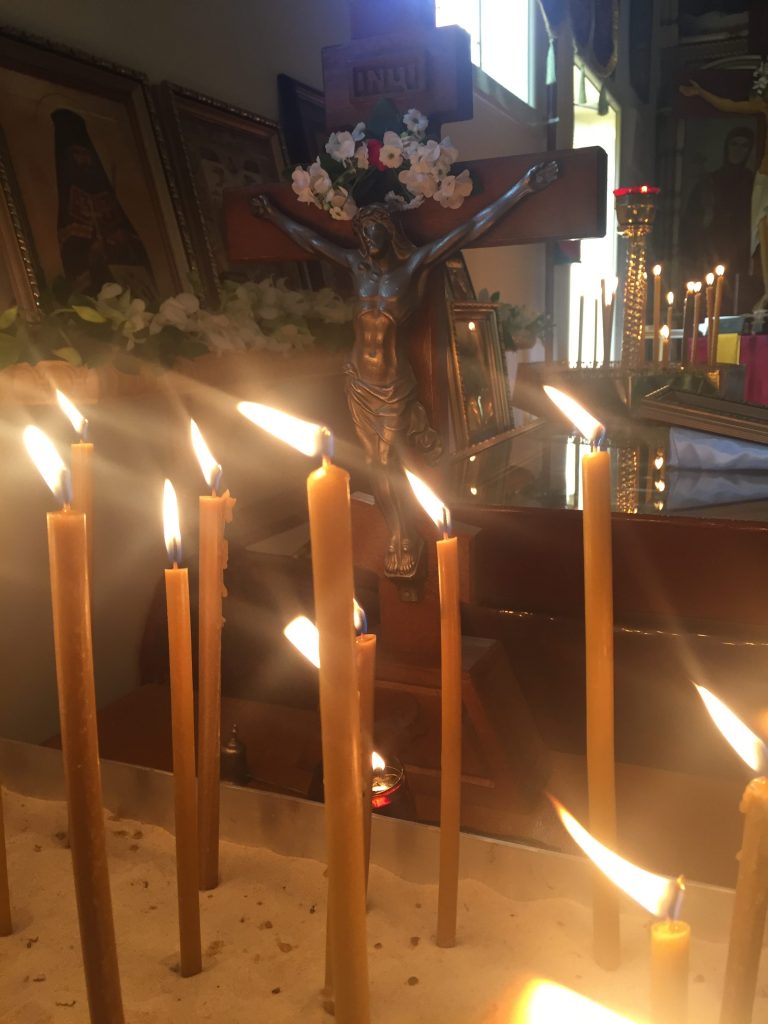
A narrative by a Mt.Athos monk about a vision during a requiem service.
Translated by Seraphim Larin
It was a Saturday for the Commemoration of the Dead and the Liturgy had just finished. Some parishioners had already started to leave the church while the remaining began to gather around the kanun (memorial table), which was usually located in the middle of the church for the requiem service (pannikhida).
I was standing in the choir gallery. The priest and the deacon emerged from the altar, the former exclaiming: “Blessed is our God, now and ever, and to the ages of ages. Amen”. The deacon lit the candles and commenced to distribute them to those present. At that moment, I noticed many people starting to enter through the door into the church from the street, and others permeating through the walls and windows. The church filled with many of these transparent apparitions. Among this mass I noticed women, men, children and infants. By their outward appearance, I was able to determine that there were priests, emperors, bishops ordinary workers and everyday people in general.
Upon the priest’s utterance, they silently filled the whole church with extraordinary rapidity, standing one behind the other. They all appeared to be endeavouring to reach the memorial table, but for some reason were unable to get close to it. I couldn’t tear my eyes away from this amazing scene.
Finally, because of the assembled multitude, the real worshippers present appeared to me as figures that have been vividly drawn against a background of these astonishing shadows. Wordlessly, these spirits approached and stood at the holy altar. Some of them kneeled while others bowed their heads, as though clearly expecting the pronouncement of a judgment. The children were stretching out their hands toward the lit candles on the table, as well as towards the hands of the praying worshippers.
Then the deacon took out the lists of names of the dead to be commemorated, and began reading them. My amazement knew no bounds when I noticed when one, then another figure abruptly detaching itself joyfully, thus separating itself from the throng. They were coming up to those that have commemorated them, and stood at their side while looking at them with eyes full of love and joyful tranquility. I also noticed some type of spiritual candles that were lit, appeared in the hands of the spirits – whose faces were shining with what seemed to be extraordinary living rays – and were also praying for those worshippers who were praying for them.
When the names were read out, they joyfully stepped out from the mass of silent shadows. They soundlessly moved and merged with the living worshippers. Finally, when all the lists of commemorative names were mentioned, there were many whose names were not read. They were saddened, and their heads were bowed, as though they have come to a vast festivity where they were ignored by those who could have invited them to this celebration that was of great importance to them. Some of the souls kept glancing anxiously at the doorway, as if expecting that maybe one of their close friends may arrive and in turn, call out their name.
Alas, no new faces arrived, causing those un-commemorated souls to attach themselves to the happiness of those who were mentioned with their participating live individuals.
I began to observe the general group of worshippers – which had merged with the apparitions from the other world, radiating with shimmering rays – and witnessed a more remarkable scene.
When during the service, the following words were pronounced: “ Blessed art Thou, O Lord: teach me Thy statutes” or “ Give rest, O Lord, to Thy departed servants”, I noticed how the faces of the living lit up with the same radiance as those of the faces of the departed… how their hearts blended into one common heart… how tears of joy and not despondency started to flow from the eyes of those that had their physical form, while at the same time, what fervent love and infinite devotion glowed in the eyes of those commemorated.
Amid fragrant clouds of frankincense and streams of smoke from the burning candles, when the wonderful prayerful invocation resounded: “With the Saints give rest, O Christ..” the whole congregation – like one body, fell to its knees, and those spirits whose names were commemorated, prayed for those present as well as for themselves. Whereas those whose names were not mentioned, prayed only for themselves.
When the prayerful church singing ended, the candles extinguished, the concluding prayer uttered by the priest and a general commemoration of the departed pronounced by the deacon, all the apparitions began to disappear. Finally, only those worshippers remained that wanted to have a private pannikhida served for their departed. Then I noticed on their faces such tranquility, such gratification and such spiritual rejuvenation, that I am incapable of conveying them.
Great, holy and comforting is the rite of the Orthodox Church for the departed… and how sorrowful for those when they are subjected to neglect through forgetfulness, thereby denying them not only the joy of being commemorated –for example during Liturgy – but retarding their spiritual restoration and forgiveness of their sins by Christ. This is because every time the priest takes out a piece from the prosphora for the repose of the departed soul, those souls receive mercy and come closer to God’s Kingdom.
This spiritual thirst of the departed to be remembered will be experienced by each and every one of us. That’s why they often remind us of their existence – on the eve of their birthdays, their deaths or Commemoration Saturdays – by appearing in our dreams.
Our every word, thought or recollection about a departed soul, has an immediate impact on it. Moreover, if the recollection is good – the impact is joyful, and if it’s bad – the impact is agonizing, because it evokes a gnawing conscience. One can imagine the horrifying torment beyond the grave for those who cannot be remembered for anything good.
That’s why the practice in general humanity demands that we do not speak ill of the dead, so as not to aggravate their spiritual wounds. All this must serve as a warning to us: to live in such a manner so that after our death, we do not merit contempt, censure or hatred, and even still worse – be accursed, thereby forfeiting prayers from our close ones.

